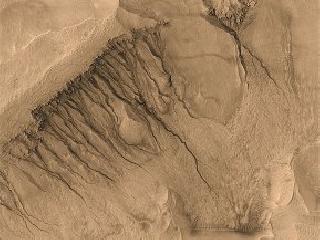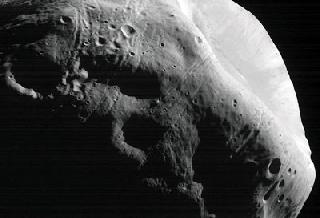
The Martian surface. A NASA photo
HOUSTON (BNS): Liquid water has interacted with the Martian surface throughout the planet's history as well as in recent times, a new research suggests.
The Red planet has also witnessed volcanic activity in the recent past, scientists analysing data provided by NASA's Phoenix Mars Lander have found.
The latest findings are based on the carbon dioxide content found on Mars which makes up about 95 percent of the Martian atmosphere.
“Atmospheric carbon dioxide is like a chemical spy. It infiltrates every part of the surface of Mars and can indicate the presence of water and its history,” according to Paul Niles, a space scientist at NASA's Johnson Space Center in Houston.
The Phoenix spacecraft, which has now gone silent, had precisely measured isotopes of carbon and oxygen in the carbon dioxide, indicating that liquid water primarily existed at temperatures near freezing.
Measurements concerning carbon dioxide showed Mars is a much more active planet than previously thought. The results imply Mars has replenished its atmospheric carbon dioxide relatively recently, and the gas has reacted with liquid water present on the surface, NASA said.
A detailed study of the carbon isotopes – (variants of carbon with different atomic weights) – also led scientists to another interesting observation.
The low gravity and lack of magnetic field on Mars result in loss of carbon dioxide into space. This process favours loss of a lighter isotope named carbon-12 compared to carbon-13.
If Martian carbon dioxide had experienced only this process of atmospheric loss without some additional process replenishing carbon-12, the ratio of carbon-13 to carbon-12 would be much higher than what Phoenix measured.
This suggests the Martian atmosphere recently has been replenished with carbon dioxide emitted from volcanoes, and volcanism has been an active process in Mars' recent past, the researchers say.
Two oxygen isotopes found in the Martian carbon dioxide – oxygen-18 and oxygen-16 – however, do not bear any volcanic signature.
This suggests that carbon dioxide has reacted with liquid water, which enriched the oxygen in carbon dioxide with the heavier oxygen-18. It also indicates that liquid water has been present on Mars' surface recently enough and abundantly enough to affect the composition of the current atmosphere, NASA said.
 Previous Article
Previous Article Next Article
Next Article













The Indian Air Force, in its flight trials evaluation report submitted before the Defence Ministry l..
view articleAn insight into the Medium Multi-Role Combat Aircraft competition...
view articleSky enthusiasts can now spot the International Space Station (ISS) commanded by Indian-American astr..
view article